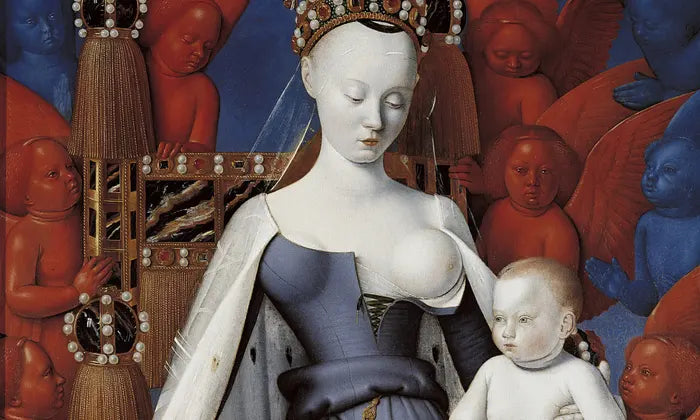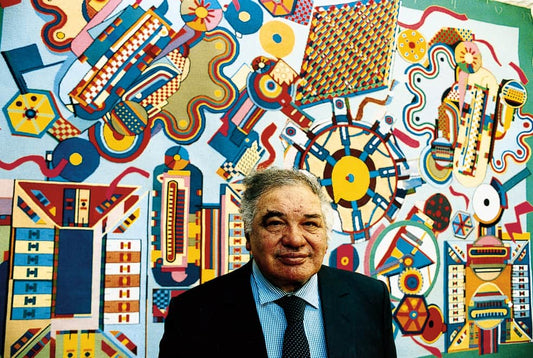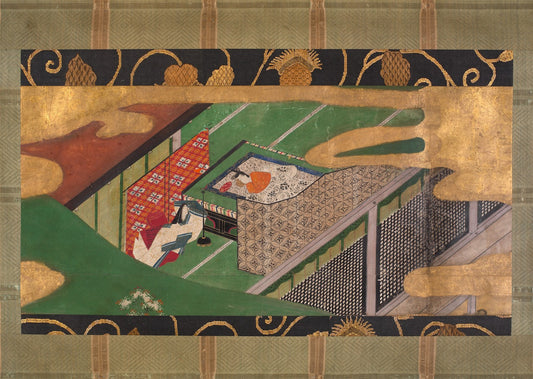Feature image: Virgin and Child Surrounded by Angels by Jean Fouquet. Photograph: Heritage Images/Getty Images via The Guardian
Body Fluids in Art: Breast Milk
For centuries, the image of Mary breastfeeding the baby Jesus was a prominent part of Christian iconography. This imagery was meant to highlight the compassion and humility of Mary and to communicate the nursing, motherly aspect of Mary’s love of Jesus. Nursing Madonnas first appeared around the twelfth century in Italy and Spain. However, by 1563, these images were abandoned after the Council of Trent deemed the works inappropriate and too sexual. Unfortunately, Western cultural norms regarding the sexualized taboo of public breastfeeding have persisted into the present day, as women still face social backlash for breastfeeding in public. Women’s bodies are so often subject to over-sexualization that something as decidedly non-sexual as feeding a child has been scandalized and thus deemed inappropriate for public settings. The manner and location at which a new parent feeds their child is a personal choice, not a public decision. For many new parents, the journey of breastfeeding is rife with stress, joy, and every emotion in between. While this article focuses on artistic depictions of breastfeeding, it is important to note that many women are placed under undue stress to breastfeed and shamed if, for whatever reason, they are unable to breastfeed their child.

Ine Poppe, Dutch Mother’s Milk (1983)
In Dutch Mother’s Milk, Ine Poppe explored what it meant to be a milk-producing being. This work was a multimedia project that incorporated elements of music, video, photography, and performances. A central part of the work was cheese made from Poppe’s breast milk. Images of Poppe pumping and making the cheese are all included in the piece, alongside the music, which was created from baby hiccups. While the work was positively received in the US and in Japan, it received backlash in the Netherlands. Poppe’s mostly male Dutch contemporaries ostracized her, and a Dutch newspaper said the work “makes us puke.” Poppe’s work was eventually embraced by the Dutch and is now heralded as the pinnacle of Dutch media art. Poppe has come to be considered a trailblazer in combining media art and feminist critique and is credited with inspiring future artists such as Tracey Emin.

Mother Artists Making Art (MAMA), Milkstained (1998)
Mother Artists Making Art (MAMA) is a collective of people who welcome all who identify with the word mother to embrace a world where mother and artist occupy a shared space. In their 1998 multisensory performance, Milkstained, these mothers explored their postpartum bodies and the social taboos around the maternal experience. The work was performed at the Electronic Café International in Santa Monica and was also live-streamed. Milkstained began with a naked woman lying on a white pedestal and draped in white cloth. White liquid began to pour down her back, at which point more women joined the stage and began hand-expressing milk from their breasts. They poured the milk into a fountain of cocktail glasses while spoken word sounds of a baby feeding and the whir of an electric breast pump filled the space. To finish, the audience was invited to taste the fresh milk. Of the work, MAMA described it as a “spilling, pouring, dripping, a sense of a fantastic abundance, the release of bodily fluids as in the sexual act, the tension and the feeling of disorder produced by liquids overrunning their containers.”

Jess Dobkin, The Lactation Station Breast Milk Bar (2006)
The Lactation Station Breast Milk Bar was inspired by wine tasting. Jess Dobkin began the work by finding and interviewing six breastfeeding mothers. She then created an exhibit inviting audience members to taste the different people's milk, which was all pasteurized for health and safety reasons. As patrons tasted the pasteurized human milk, the interviews of the women who donated played in the background. In these interviews, the donor's diet, time of expression, age of their child, and details about the woman's experience breastfeeding were all shared. Through this work, Dobkins invited patrons to have an open "dialogue about trust, risk, taste, culture, and bodily fluids." This work first occurred in 2006, but occurred again in 2012 and 2016.

Lynn Lu, Baraka (2013)
Lynn Lu’s Baraka, an Arabic word that translates to blessing, is a performance piece exploring how caretakers' (breastfeeding women's) labor is often overlooked. In Baraka, Lu stood before an audience wearing a simple black dress with a gray shawl wrapped around her. She read an academic paper titled “From Folklore to Scientific Evidence: Breastfeeding and Wet-Nursing in Islam and the Case of Non-Puerperal Lactation.” Those closest to Lu also noticed a rhythmic hum and the shape of a breast pump under Lu’s shawl. Once Lu finished her reading, she poured the freshly expressed milk into porcelain spoons that she then fed to audience members, one person at a time. Lu acts as caretaker and provider as she spoon-feeds her audience, who take on the role of child or someone in need of help.

Aimee Koran, Milkscapes (2016-present)
The idea for Milkscapes was stumbled upon after a newly breastfeeding Aimee Koran knocked over a bottle of her breast milk onto a page in her sketchbook. Koran was intrigued by the pattern created from the spilled milk and watched how, over time, the milk curdled, dried, and cracked. She began experimenting with how to incorporate breast milk into her work. Koran now creates inkjet prints on paper and fabric of breastmilk fabric on Mylar. The resulting works are abstract and filled with interesting shapes and textures.

On Koran’s website, she states, “My breast milk performed as the material trace of my transition into my new role as mother; beautiful but messy, quiet and calm yet chaotic and unpredictable, and profoundly abstract while similarly rooted in reality. Produced for her. Only for her. Only from me. Breast milk is the material created from an intimate exchange of body to body.”
Eva Zasloff, Reflections of light on breastmilk particles (2018)
Eva Zasloff is a physician who cares for families in the fourth trimester. She spends a large portion of her time thinking and talking about breastmilk. In Reflections of light on breastmilk particles, Zasloff captures images of light reflecting off of breastmilk through the lens of a microscope. The resulting images look like their own galaxies. The milk used in these images, donated by postpartum women, is portrayed at 750x magnification to capture the smallest of details in the milk particles.

Of these works, Zasloff said, “These images are projected to create a dreamscape space where we can stargaze at the microscopic views of light reflecting on breast milk.”
OONA and Lori Baldwin, Milking the Artist (2022)
Milking the Artist, which was OONA and Lori Baldwin's guerilla performance piece, was displayed at Scope Gallery during Art Basel. In this work, OONA and Lori talked about the fetishization of female bodies, then OONA produced breast milk in a glass and put it up for auction. The first glass of milk sold for $200,000. Baldwin wore a brilliant all-white outfit featuring a long button-up coat miming a doctor's lab coat. OONA donned a pair of white pants with black lettering, black, hoof-like shoes, a black top with a large hole in the front to reveal her prosthetic breasts, and a black face covering. OONA also had cow print nails and a name tag around her neck. The artists were removed from the gallery because the performance was deemed too controversial, a decision that was met with backlash across the art world. The artists shared that "the work revolves around the concept of ownership, value, censorship, and consumption."
Some women have also begun incorporating breastmilk into keepsakes such as artworks or in jewelry. Artist Gina Jones is an example of this, as she preserves and refines her clients’ breastmilk and uses them to paint an image of the woman breastfeeding or of their family. These keepsakes speak to women’s breastfeeding experiences and the joy and hardship that can accompany this journey. The range of experiences women have with breastfeeding is reflected in these works. Each work strives to convey a different purpose; they discuss the over-sexualization of women’s bodies, the feeling of being overlooked as a caretaker, and even being desexualized in a postpartum body. This collection of works speaks to the often contrasting roles that women are expected to fill under the heel of patriarchy, even when it comes to feeding their own children.
©ArtRKL™️ LLC 2021-2024. All rights reserved. This material may not be published, broadcast, rewritten or redistributed. ArtRKL™️ and its underscore design indicate trademarks of ArtRKL™️ LLC and its subsidiaries.





